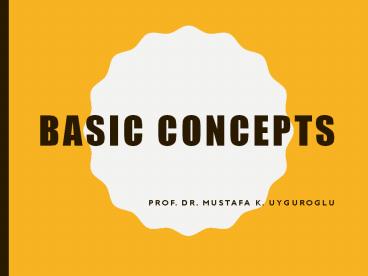BASIC CONCEPTS - PowerPoint PPT Presentation
Title:
BASIC CONCEPTS
Description:
Title: BASIC CONCEPTS Author: Mustafa Uyguroglu Last modified by: Mustafa Uyguroglu Created Date: 3/5/2003 6:37:18 AM Document presentation format – PowerPoint PPT presentation
Number of Views:509
Avg rating:3.0/5.0
Title: BASIC CONCEPTS
1
BASIC CONCEPTS
- Prof. Dr. Mustafa K. Uyguroglu
2
ElectrIc CIrcuIt
- An electric circuit is an interconnection of
electrical elements.
3
ElectrIc CIrcuIt
4
Systems of UNITS
- When taking measurements, we must use units to
quantify values - We use the International Systems of Units (SI for
short)
5
Systems of UNITS
Quantity Basic Unit Symbol
Length meter m
Mass kilogram kg
Time second s
Electric current ampere A
Thermodynamic Temperature kelvin K
Luminous intensity candela cd
6
The SI PrefIxes
- Prefixes on SI units allow for easy relationships
between large and small values
7
Charge
- Charge is a basic SI unit, measured in Coulombs
(C) - Charge of single electron is 1.60210-19 C
- One Coulomb is quite large, 6.241018 electrons.
8
Charge
- In the lab, one typically sees (pC, nC, or µC)
- Charge is always multiple of electron charge
- Charge cannot be created or destroyed, only
transferred.
9
ElectrIc Current
- The movement of charge is called a current
- Historically the moving charges were thought to
be positive - Thus we always note the direction of the
equivalent positive charges, even if the moving
charges are negative.
10
ElectrIc Current
- Current, i, is measured as charge moved per unit
time through an element. - Unit is Ampere (A), is one Coulomb/second
11
DC vs. AC
- A current that remains constant with time is
called Direct Current (DC) - Such current is represented by the capital I,
time varying current uses the lowercase, i. - A common source of DC is a battery.
- A current that varies sinusoidally with time is
called Alternating Current (AC) - Mains power is an example of AC
12
DIrectIon of current
- The sign of the current indicates the direction
in which the charge is moving with reference to
the direction of interest we define. - We need not use the direction that the charge
moves in as our reference, and often have no
choice in the matter.
13
DIrectIon of Current II
- A positive current through a component is the
same as a negative current flowing in the
opposite direction.
14
Voltage
- Electrons move when there is a difference in
charge between two locations. - This difference is expressed at the potential
difference, or voltage (V). - It is always expressed with reference to two
locations
15
Voltage II
- It is equal to the energy needed to move a unit
charge between the locations. - Positive charge moving from a higher potential to
a lower yields energy. - Moving from negative to positive requires energy.
16
Power
- Power time rate of expending or absorbing energy
- Denoted by p
- Circuit Elements that absorb power have a
positive value of p - Circuit Elements that produce power have a
negative value of p
17
Energy
18
PassIve SIgn ConventIon
19
PSC Example I
20
PSC Example II
21
PSC Example III
22
CIrcuIt Elements
- Ideal Independent Source provides a specified
voltage or current that is completely independent
of other circuit variables - Ideal Independent Voltage Source
23
CIrcuIt Elements
- Ideal independent current source
24
CIrcuIt Elements
- Ideal dependent voltage source
- Ideal dependent current source
25
Dependent Source example
- The circuit shown below is an example of using a
dependent source. - The source on the right is controlled by the
current passing through element C.































